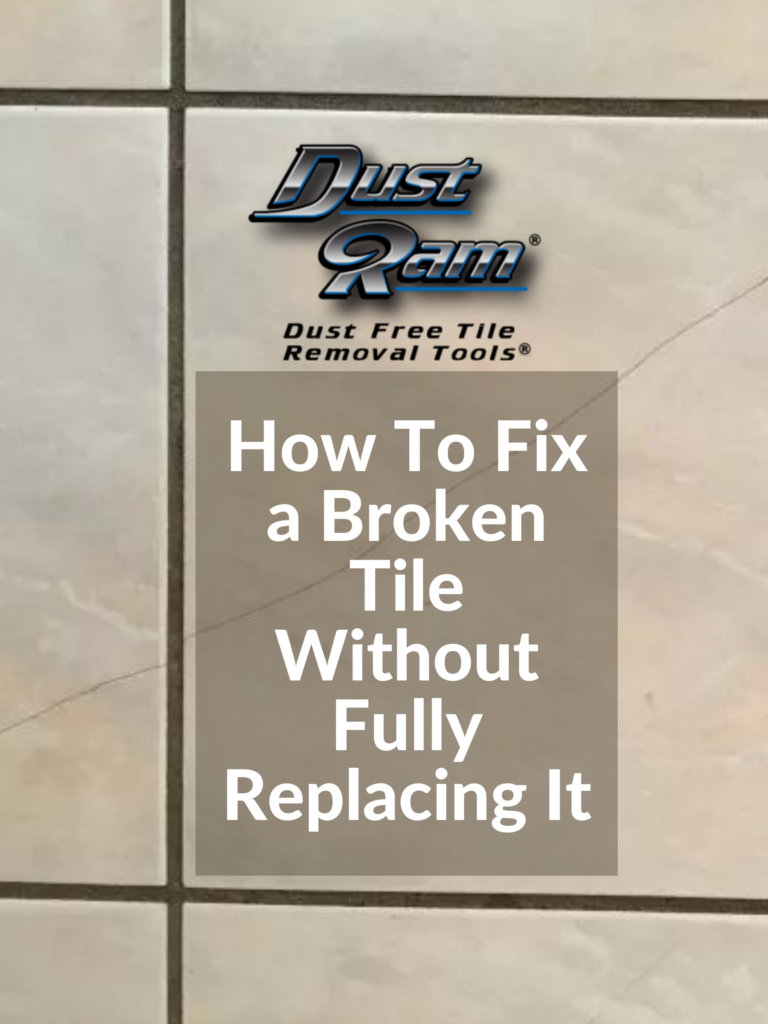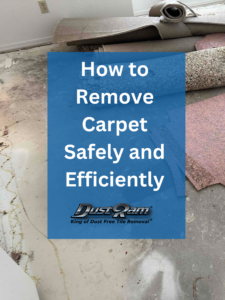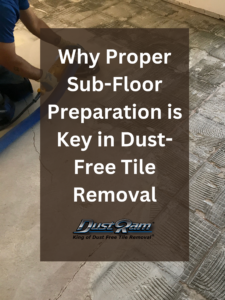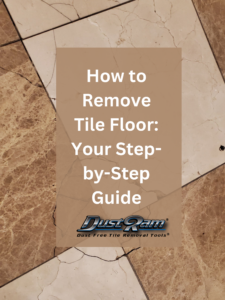
Photo Credit: HomeTalk
How To Fix a Broken Tile Without Fully Replacing It?
Accidents happen, and sometimes, tiles get damaged. But what if you could fix broken tiles without going through the hassle of removing and replacing the entire piece? In this comprehensive guide, we’ll show you how to repair various types of broken tiles without fully replacing them, saving you time, effort, and resources.
Follow along with DustRam® to learn the few strategies that you can follow to repair any tiles that are currently cracked.
Can My Tile Flooring Get Water Damaged?
Materials and Tools Needed:
-Epoxy resin or tile repair adhesive
-Toothpicks or small brush
-Putty knife or spatula
-Paintbrush
-Matching paint (if necessary)
-Grout (if necessary)
-Grout sponge or cloth
-Protective gloves
-Painter’s tape
-Clear nail polish (for minor scratches)
-Fine-grit sandpaper (for minor scratches)
Related Post: How to Prepare Your Subfloor For Tile Installation
Types of Tile Damage and Their Solutions:
Before diving into the step-by-step guide, it’s important to understand the different types of tile damage and the appropriate solutions for each.
Minor Scratches:
For small scratches on the tile’s surface, you can use clear nail polish or fine-grit sandpaper to make them less visible.
Small Chips:
If the tile has small chips, use epoxy resin or tile repair adhesive to fill in the missing pieces.
Cracks:
For cracked tiles, apply an epoxy resin or tile repair adhesive to bind the broken parts together and prevent further damage.
Missing Pieces:
If a tile has a larger missing piece, use epoxy resin or tile repair adhesive to fill in the gap, followed by painting and re-grouting as needed.
If you are interested in getting your tile removed, contact our team today and inquire about our dustless tile removal services.
How to Choose the Right Flooring for Your House?
Step 1: Assess the Damage
Inspect the broken tile to determine the extent of the damage and decide which repair method is most suitable. If the tile is cracked, chipped, or has small missing pieces, you can likely repair it without fully replacing it. However, if the damage is extensive or affects the structural integrity of the tile, replacement may be necessary.
Step 2: Clean the Damaged Area
Before repairing the broken tile, make sure the damaged area is clean and free of debris. Use a cloth or brush to remove any dirt or loose pieces from the affected area. For minor scratches, use fine-grit sandpaper to gently sand the scratch and the surrounding area.
Step 3: Choose the Appropriate Repair Method
Based on the type of damage, choose the appropriate repair method:
–For minor scratches, apply a thin layer of clear nail polish to the scratch, allowing it to dry completely. This will help make the scratch less noticeable.
–For chips, cracks, or missing pieces, proceed to the next step.
Step 4: Mix and Apply Epoxy Resin or Tile Repair Adhesive
Put on protective gloves and mix the epoxy resin or tile repair adhesive according to the manufacturer’s instructions.
Using a toothpick or a small brush, carefully apply the adhesive to the damaged area, filling in any gaps or missing pieces.
Be sure to apply enough adhesive to create a smooth, even surface. Use painter’s tape to secure any cracked pieces in place while the adhesive cures, if necessary.
Step 5: Remove Excess Adhesive
Once the adhesive is applied, use a putty knife or spatula to remove any excess adhesive, ensuring the repaired area is level with the rest of the tile. Allow the adhesive to cure for the recommended time stated by the manufacturer.
Should I Replace Flooring Before Selling My Home?
Step 6: Paint the Repaired Area (Optional)
If the repaired area doesn’t match the rest of the tile, you may need to paint it to blend in. Use a small paintbrush to apply matching paint to the repaired area, making sure to feather the edges for a seamless appearance.
Allow the paint to dry before proceeding. To achieve the best color match, consider bringing a sample or photo of the existing tile to a paint store to have them create a custom color for you.
Step 7: Apply Grout (If Necessary)
If the repair involved the tile’s grouted edges, you might need to reapply grout to those areas. Mix the grout according to the manufacturer’s instructions, and use a grout sponge or cloth to apply it.
Be sure to wipe away any excess grout before it dries. If you’re unsure about the right type of grout to use, consult with a professional or visit a local home improvement store for guidance.
Step 8: Seal the Grout (Optional)
To protect the repaired area and surrounding grout from future damage, consider applying a grout sealer once the grout has fully cured. This will help prevent moisture absorption and staining. Follow the manufacturer’s instructions for proper application and drying time.
Step 9: Clean and Polish the Repaired Tile
Once the adhesive, paint, and grout (if applicable) have dried, clean the repaired tile with a damp cloth or sponge to remove any residue. You can also use a gentle tile cleaner if necessary. Buff the repaired area with a dry cloth for a polished finish.
How to Choose the Right Flooring for Your House?
Step 10: Regular Maintenance and Prevention
To minimize the risk of future tile damage, regularly inspect and clean your tiles. Address minor scratches or chips as soon as they appear to prevent them from becoming more extensive issues. Additionally, consider using protective pads or rugs in high-traffic areas or under heavy furniture to reduce the risk of damage.
Repair, Restore, and Maintain Your Tiles with Confidence
Fixing broken tiles without fully replacing them can be a cost-effective and time-saving solution for minor damages. By following this comprehensive guide, you can restore the appearance and functionality of your tiles with minimal effort.
Just remember to assess the damage carefully, choose the appropriate repair method, and consider professional help if the damage is extensive or beyond your skill level. Regular maintenance and prevention measures will also help ensure your tiles stay in great condition for years to come.
Blog









